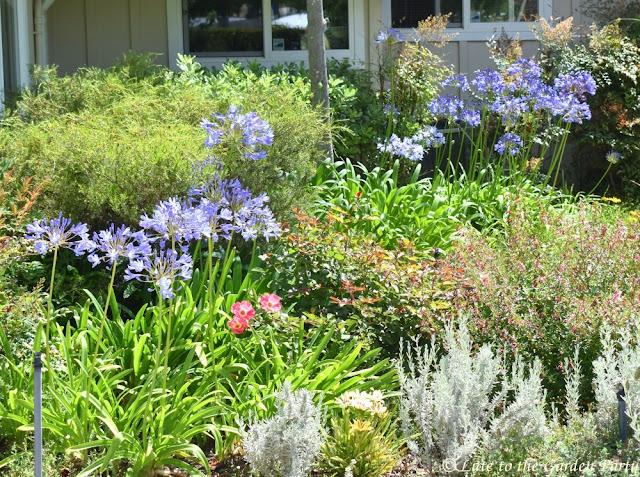The title of this post has nothing to do with my mental state, even through the month of June has been a turbulent to say the least. The focus of my post is entirely on the blue-flowered plants in my garden. I'll try growing just about any plant with blue flowers that has the slightest chance of surviving in my climate. Of those that I've successfully established in my garden, it seems that the largest number of them flower in summer. Here's the current line-up:
![]() |
| The Agapanthus (aka Lily of the Nile) came with the garden. I've never had an accurate count of them and over time I've pulled out some clumps, dividing bulbs and replanting some of them, but I'd guess there are at least 40 clumps spread throughout the property. Those shown in this photo are a portion of what's in the back garden. |
![]() |
| These are in the front garden |
![]() |
| I don't have any of the midnight blue varieties of Agapanthus, nor any bi-colors. Mine range from medium blue to light blue to white. |
![]() |
| Catananche caerulea (aka Cupid's dart) has self-seeded freely here |
![]() |
| Several years ago I fell in love with the rose-like double-petaled form of Eustoma grandiflorum (aka lisianthus). It's a short-lived perennial in my climate. Breeders have recently introduced a broad variety in different colors, many of which I've tried. Still, the blue cultivar is one of my favorites. It's the first and thus far the only one to bloom to date this season. |
![]() |
| Globularia x indubia (aka globe daisy) hails from the Canary Islands. I originally bought it for its foliage but I love its flowers too. |
![]() |
| I planted this lavender my first year in this garden and I don't have any record of its name but I think it's a Lavandula angustifolia. I put in just one plant here but it cleverly encircled the birdbath, which is filled with glass marbles rather than water. |
![]() |
| Lavandula multifida, a hybrid commonly known as fern lavender or California lavender, is difficult to photograph. I cut this one back just last week but it's already got lots of bloom spikes. |
![]() |
| Limonium perezii (aka sea lavender) has been blooming for months. It's in the final stages of its annual bloom cycle now but still has a significant presence in my garden even though I've cut much of it back. This plant is also a native of the Canary Islands. |
![]() |
| This is another plant I have difficulty photographing. It's Plectranthus neochilus (aka lobster flower) and it stinks, literally. The foliage smells like a skunk's spray and the warmer it is the more it smells. But, if you can get past that, it's a great plant. It flowers nearly continuously, makes a good groundcover, and gets by with very little water. |
![]() |
| Salvia clevelandii 'Winnifred Gilman' is also aromatic but not in a bad way. This is smaller version of the native California sage with deeper blue flowers. |
![]() |
| I got Wahlenbergia 'Blue Cloud' from Annie's Annuals & Perennials by mail order several years ago. I've never seen anything else in this genus offered elsewhere. It spreads freely and rather boisterously but it's easy enough to pull it out when it gets out of hand. It creates a meadow-like effect, even when growing among succulents. |
But wait, there's more! These are blooming as well, albeit as bit players in the garden:
![]() |
| Ageratum houstonianum (aka flossflower) has a long bloom season if dead-headed periodically |
![]() |
| Until last year, I steered clear of Delphiniums and warned my friends to do the same. I planted a 6-pack of a 'Pacific Giant' variety in my cutting garden last year on a whim and was shocked and delighted that it flowered. Treated as an annual, it can't handle our summer heat but I appreciate it in the late spring/early summer. In my cutting garden it's well-watered. I don't think it could handle the drier conditions elsewhere in my garden. |
![]() |
| I planted Nigella papillosa 'Starry Night Mix' (aka love-in-a-mist) from seed this year in my cutting garden and it did well. This is the last of it. |
![]() |
| I planted several Platycodon grandiflorus (aka balloon flower) in a semi-shaded area of the front garden a couple of years ago. They didn't handle summer well and I thought I'd pulled all of them but this one returned unexpectedly last year and it's done so again this year. Despite their reputation for requiring "regular water," I may try adding a few more if I find them in my local garden center. |
![]() |
| I photographed this Salvia cacaliifolia (aka Guatemalan sage) from an odd angle, making it look like an alien insect. Its flowers are a gorgeous shade of blue. |
![]() |
| I'd all but forgotten about planting bulbs of Triteleia laxa (aka Ithuriel's spear) last year. They didn't bloom then but I discovered a few blooms 2 weeks ago. They're shorter than they should be but welcome nonetheless. |
May your weekend proceed under a bright blue sky!
All material © 2012-2019 by Kris Peterson for Late to the Garden Party

















